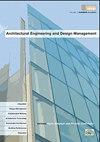模拟建筑物的能源性能:使用eQUEST和能源之星®投资组合管理器的研究
IF 2.5
4区 工程技术
Q2 CONSTRUCTION & BUILDING TECHNOLOGY
Architectural Engineering and Design Management
Pub Date : 2023-10-19
DOI:10.1080/17452007.2023.2270679
引用次数: 0
摘要
在美国,商业建筑消耗了大量的能源,并且通过改造显示出巨大的节能潜力。基准测试和能源模拟是业界公认的工具,用于识别潜在的改进和衡量性能。通过分析确定对能源性能最敏感的改造参数,可以优化投资和节约能源。本研究展示了使用静态模型来确定建筑设计和改造参数对能源性能的敏感性的方法。提出了两个配送中心(A、B)的校准模拟能量模型(eQUEST)。针对能源消耗最高的能效措施的改造参数进行了分数因子分析,并使用energy Star®Portfolio Manager对结果进行了基准测试。一个自定义的基于Microsoft Excel®的模拟模型被创建,以模拟占用水平,照明,插头负载,以及全天在不同空间使用的其他设备。对于A栋而言,高效照明是影响节能、碳减排和基准得分的最重要参数;而对于B栋,暖通空调效率对能源和需求控制通风的影响最大,节能器对基准得分的影响最大。虽然改造项目可以节省能源和碳排放,改变源址比率和国家电网的排放,但基准得分可能并不总是反映出同等的改善。国家电网排放因素、天然气成分难以建模,因此本研究未考虑。提出的协同分析强调了基准和效率改造在促进可持续建筑实践以减少能源消耗方面的重要性。关键词:能源模拟能源基准能源之星投资组合经理改造和设计参数敏感性分析披露声明作者未报告潜在的利益冲突。数据可用性声明支持本研究结果的数据可应通讯作者b.g.的合理要求获得。本研究得到了美国能源部的支持。本文章由计算机程序翻译,如有差异,请以英文原文为准。
Simulating energy performance of buildings: a study using eQUEST and Energy Star® portfolio manager
ABSTRACTCommercial buildings consume significant energy in the United States and exhibit high potential for energy use reduction through retrofits. Benchmarking and energy simulation are well established tools in the industry to identify potential improvements and measure performance. Analysis to identify most sensitive retrofit parameters to energy performance can optimize investment and available energy savings. Presented study demonstrates methodology using a static model to determine sensitivity of building design and retrofit parameters with respect to energy performance. Calibrated simulation energy models (eQUEST) of two distribution centers (A, B) are presented. A fractional factorial analysis is conducted on retrofit parameters of efficiency measures targeting the highest energy consumers, and the results are benchmarked using Energy Star® Portfolio Manager. A custom Microsoft Excel® based simulation model is created to simulate occupancy levels, lighting, plug loads, and other equipment used in various spaces throughout the day. For Building A, efficient lighting was the most influential parameter for energy savings, carbon savings and benchmarking score; whereas, for Building B, HVAC efficiency was most influential for energy and demand controlled ventilation and economizers was most influential for benchmarking score. While retrofit projects can save energy and carbon emissions, variation in source-site ratios and state grid emissions, benchmarking scores may not always reflect equivalent improvement. State grid emissions factors, natural gas composition are difficult to model and hence not considered in this study. The synergistic analysis presented, emphasizes the importance of benchmarking and efficiency retrofits in promoting sustainable building practices to reduce energy consumption.KEYWORDS: Energy simulationeQUESTenergy benchmarkingEnergy Star® Portfolio Managerretrofit and design parameterssensitivity analysis Disclosure statementNo potential conflict of interest was reported by the author(s).Data availability statementThe data that support the findings of this study are available from the corresponding author, B.G., upon reasonable request.Additional informationFundingThis work was supported by U.S. Department of Energy.
求助全文
通过发布文献求助,成功后即可免费获取论文全文。
去求助
来源期刊
CiteScore
5.80
自引率
3.40%
发文量
30
期刊介绍:
Informative and accessible, this publication analyses and discusses the integration of the main stages within the process of design and construction and multidisciplinary collaborative working between the different professionals involved. Ideal for practitioners and academics alike, Architectural Engineering and Design Management examines specific topics on architectural technology, engineering design, building performance and building design management to highlight the interfaces between them and bridge the gap between architectural abstraction and engineering practice. Coverage includes: -Integration of architectural and engineering design -Integration of building design and construction -Building design management; planning and co-ordination, information and knowledge management, vale engineering and value management -Collaborative working and collaborative visualisation in building design -Architectural technology -Sustainable architecture -Building thermal, aural, visual and structural performance -Education and architectural engineering This journal is a valuable resource for professionals and academics (teachers, researchers and students) involved in building design and construction, including the following disciplines: -Architecture -Building Engineering -Building Service Engineering -Building Physics -Design Management and Design Coordination -Facilities Management Published papers will report on both fundamental research dealing with theoretical work and applied research dealing with practical issues and industrial innovations. In this way, readers explore the interaction between technical considerations and management issues.

 求助内容:
求助内容: 应助结果提醒方式:
应助结果提醒方式:


